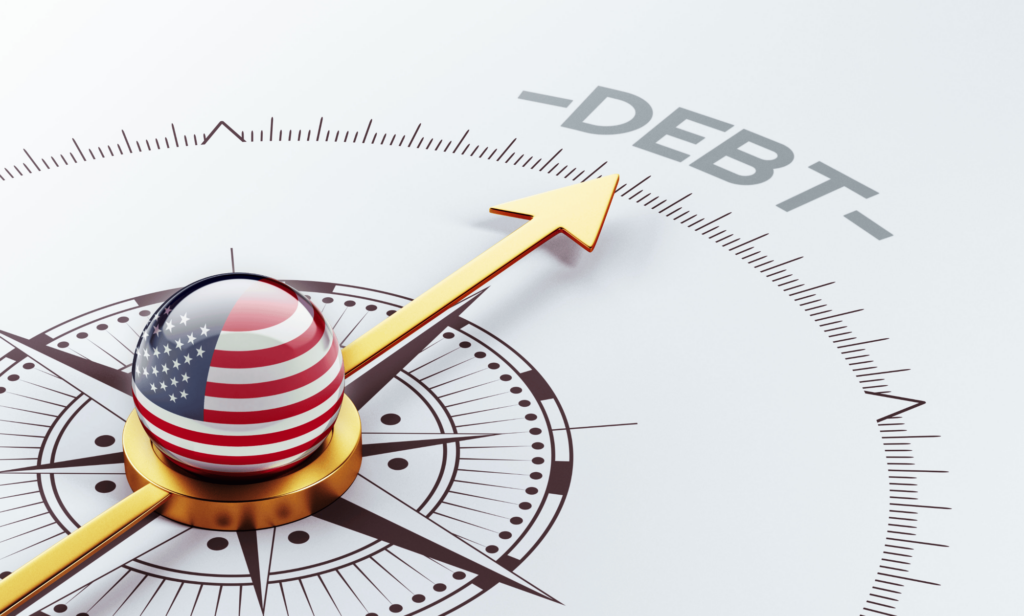|
Getting your Trinity Audio player ready...
|
You’ve probably heard of the United States Debt Clock, that ever-increasing number ticking away, representing the national debt. But what exactly is it, and why should you care? Let’s dive deep into this topic and unravel the mysteries behind this digital timepiece and its implications on inflation.
Understanding the Debt Clock
First things first, the United States Debt Clock is a real-time representation of the national debt. Imagine a stopwatch that, instead of counting seconds, counts dollars. And not just a few dollars here and there, but trillions of them. It visually represents how much the U.S. federal government owes to its creditors. The clock doesn’t stop, and that’s because the debt is continuously accruing interest.
You might be wondering, “How did we get here?” The answer is multifaceted. The national debt accumulates when the federal government spends more than it takes in from taxes and other revenue sources.
This deficit spending has been a common practice, especially during times of war, economic downturns in financial markets, or significant federal initiatives. Over the years, these deficits have added up, leading to the astronomical figure you see on the clock today.
Inflation and the Debt: The Connection
Inflation is the rate at which the general level of prices for goods and services rises, causing purchasing power to fall. Think of it as the reason why your grandparents could buy a candy bar for just a nickel, while today, you’re shelling out more than a dollar for the same treat. But how does the national debt play into this?
When the government is in debt, one of the ways it can raise money is by issuing treasury bonds. Investors, foreign governments, and even the Federal Reserve Bank or Federal Financing Bank buy these bonds and treasury bills. When the Federal Reserve buys these government bonds, it essentially “prints” more money, increasing the money supply. A larger money supply can lead to inflation if it outpaces economic growth.
Moreover, to service its government debt, the federal government might print more money, especially if it’s unable to raise enough through taxation or government borrowing. Without a corresponding increase in goods and services, this increase in the money supply can lead to inflation.
Watch this free precious metals training video to learn more about how to properly hedge against inflation with precious metals.
The Real-World Implications
So, what does this mean for you and me? Inflation can erode our purchasing power. That means the money in our pockets doesn’t stretch as far as it used to. This can be especially problematic for those living on fixed incomes, like retirees. It can also impact interest rates, affecting everything from the cost of borrowing money to buy a home to the returns on our savings accounts.
However, it’s essential to note that while the national debt can influence inflation, it’s not the sole factor. Other elements, like supply chain disruptions, global economic conditions, and changes in consumer demand, can also play a significant role.
Fascinating Facts About the U.S. Debt Clock and Inflation

Let’s take a moment to digest some intriguing tidbits about the U.S. Debt Clock and the broader economic landscape. These facts might just give you a fresh perspective on the topic:
- Origin of the Debt Clock: The U.S. National Debt Clock was first installed in 1989 by real estate developer Seymour Durst in New York City. It was his way of highlighting the rising government debt and encouraging people to think about fiscal responsibility.
- A Brief Pause: Believe it or not, there was a moment in 2000 when the Debt Clock actually ran backward! This was due to budget surpluses in the late 1990s. However, the clock started ticking forward again as the surpluses turned to deficits.
- Foreign Debt Holders: China and Japan are among the largest foreign holders of U.S. debt. Their investments in U.S. treasury securities run into the trillions.
- Inflation’s Historical Peaks: The U.S. has seen some significant inflation spikes in the past. The period after World War II and the late 1970s and early 1980s were particularly notable. In 1980, the inflation rate even touched a staggering 13.5%!
- Not Just a U.S. Phenomenon: While the U.S. Debt Clock garners much attention, many countries worldwide grapple with national debt issues. Countries like Japan have an even higher debt-to-GDP ratio than the U.S.
- The Gold Standard and Inflation: The U.S. abandoned the gold standard in 1971, a system where the dollar was directly linked to gold reserves. Some economists argue that moving away from this standard has made it easier for the government to print money, potentially contributing to inflation.
- The Power of Compounding: Interest on the national debt compounds over time, meaning the U.S. owes interest not just on the principal amount borrowed but also on the accumulated interest. This compounding effect is one reason why the debt can grow so rapidly.
These facts underscore the complexity and historical depth of the U.S. Debt Clock and inflation issues. It’s not just about numbers ticking on a screen; it reflects economic decisions, global events, and policy choices made over decades.
The Visionaries Behind the U.S. Debt Clock
The U.S. Debt Clock, while a digital representation of numbers, has a human story behind it. It’s a tale of concern, foresight, and a desire to educate the public about the nation’s fiscal health. Let’s delve into the minds and motivations of those who brought this iconic clock to life.
- Seymour Durst: The original U.S. National Debt Clock was the brainchild of Seymour Durst, a prominent New York real estate developer. In 1989, disturbed by the country’s escalating debt, Durst funded and installed the clock near Times Square. His aim? To make every passerby aware of the growing financial burden on the nation. Durst’s initiative was more than just a publicity stunt; it was a genuine call to action, urging citizens and policymakers alike to address the mounting debt.
- The Durst Organization: After Seymour Durst’s passing in 1995, the stewardship of the Debt Clock fell to the Durst Organization, the family’s real estate company. They have maintained and updated the clock, ensuring its message remains loud and clear. In 2004, the clock briefly ran out of digits when the debt exceeded $10 trillion, prompting the Durst Organization to upgrade the display.
- Douglas Durst: Seymour’s son, Douglas Durst, took the mantle from his father and has been instrumental in keeping the clock’s legacy alive. He has overseen its relocation and upgrades, ensuring the clock remains a relevant and potent symbol of fiscal awareness.
- The Digital Evolution: While the physical clock in New York remains the most iconic, the concept has inspired numerous online digital versions. These digital debt clocks offer real-time updates and provide detailed breakdowns of the debt, including per capita figures and comparisons with Gross Domestic Product. The people behind these digital platforms are often economic enthusiasts, tech experts, and fiscal watchdogs, all united by a shared concern for the nation’s financial future.
How Is the US National Debt Calculated?

The U.S. National Debt is a figure often thrown around in political debates, news headlines, and economic discussions. But have you ever wondered how this colossal number is calculated? Let’s break down the components and the math behind the U.S. National Debt.
- Two Main Categories: The national debt is broadly divided into two categories:
- Debt Held by the Public refers to the amount of money the U.S. government owes to external creditors. These can be individuals, corporations, state or local governments, and even foreign governments and entities. They buy U.S. Treasury securities, essentially lending money to the government with the promise of being paid back with interest.
- Intragovernmental Holdings: This is the money the U.S. government owes to itself. Sounds strange, right? Here’s how it works: Certain government agencies, like the Social Security Trust Fund, might have surpluses. These surpluses are invested in U.S. Treasury securities, effectively lending the surplus to other parts of the government.
- Tallying Up the Debt: The U.S. Department of the Treasury’s Bureau of the Fiscal Service tracks and reports the federal debt. They monitor the government’s borrowing and discretionary spending activities daily. Adding up the outstanding amounts of all Treasury securities arrives at the total national debt.
- Interest Matters: The national debt isn’t a static figure. Even if the government stops borrowing today, the debt would still grow because of the interest accrued on existing debt. This interest is a significant component of the annual federal budget and adds to the debt if revenues do not fully cover it.
- Public vs. Gross Debt: Often, you’ll hear terms like “public debt” and “gross debt.” Public debt refers to the ‘Debt Held by the Public’ mentioned earlier. Gross debt, on the other hand, is the sum of public debt and intragovernmental holdings. When people refer to the U.S. National Debt, they typically talk about the gross debt.
- Debt Ceiling: This is a cap Congress sets on how much the government can borrow. If the debt approaches this ceiling, Congress must raise the debt limit or face a potential obligation default. The debt ceiling doesn’t prevent the government from incurring obligations but restricts its ability to pay for them.
In Conclusion
The United States Debt Clock is a stark reminder of our country’s financial obligations. While it’s easy to dismiss it as just numbers on a screen, the implications of a rising national debt, especially concerning inflation, are very real.
As informed citizens, it’s crucial to understand these connections and their potential impact on our daily lives. By staying informed and advocating for sound fiscal policies, we can hope for a future where our economy remains strong, and our purchasing power remains intact.
If you’re interested in adding precious metals to your portfolio, you can book a call with one of our precious metals specialists who can walk you through the process.
As always, you can learn more about opening a gold ira or using our MetalsEdge Storage Account.








